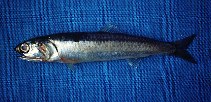| Family: |
Engraulidae (Anchovies), subfamily: Engraulinae |
| Max. size: |
20 cm SL (male/unsexed); max. reported age: 3 years |
| Environment: |
pelagic-neritic; marine; depth range 3 - 80 m, oceanodromous |
| Distribution: |
Southeast Pacific: Aguja Point, Peru to Chiloé, Chile (distribution dependent on the coastal extent of the Peru Current). |
| Diagnosis: |
Dorsal spines (total): 0-0; Anal spines: 0-0. Body elongate, slender, and rounded in cross section; snout long and prominent; lower branch of first gill arch with 34 to 49 gill rakers; anal fin with fewer than 22 rays, located behind dorsal fin base; body shiny blue or green (Ref. 55763). There is a silver stripe along flank in juveniles which disappears with age. The high number of gill rakers distinguishes it from all Pacific species of Anchoa. |
| Biology: |
Adults occur mainly within 80 km of coast, forming huge schools, chiefly in surface waters. Are filter-feeders entirely dependent on the rich plankton of the Peruvian Current. In some studies, diatoms constituted as much as 98% of the diet. Large populations of guano birds and pelicans also depend on this fish (Ref. 9988). Utilized as fish meal and oil (Ref. 9988). |
| IUCN Red List Status: |
Least Concern (LC); Date assessed: 18 August 2020 Ref. (130435)
|
| Threat to humans: |
harmless |
Source and more info: www.fishbase.org. For personal, classroom, and other internal use only. Not for publication.

